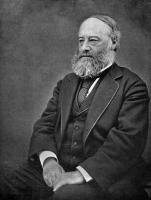| www.tmatlantic.com
Test & Soldering Equipment On-line Store |
|
D.E.V.I.C.E. (Wiki)Calculators Services |
|||||
Filter by first letter
|
Joule, James Prescott
James Prescott Joule is an English physicist, studied the nature of heat, and discovered its relationship to mechanical work. This led to the theory of conservation of energy, which led to the development of the first law of thermodynamics. The SI derived unit of energy, the joule, is named after him. The son of Benjamin Joule, a wealthy brewer, and Alice Prescott Joule, James Prescott Joule was born in the house adjoining the Joule Brewery in New Bailey Street, Salford 24 December 1818. James was tutored at the family home 'Broomhill', Pendlebury, near Salford, until 1834 when he was sent with his elder brother Benjamin, to study with John Dalton at the Manchester Literary and Philosophical Society. Dalton's influence made a lasting impression as did that of his associates, chemist William Henry and Manchester engineers Peter Ewart and Eaton Hodgkinson. Joule was subsequently tutored by John Davies. Fascinated by electricity, he and his brother experimented by giving electric shocks to each other and to the family's servants. Joule became a manager of the brewery and took an active role until the sale of the business in 1854. Science was a hobby but he soon started to investigate the feasibility of replacing the brewery's steam engines with the newly invented electric motor. In 1838, his first scientific papers on electricity were contributed to Annals of Electricity, the scientific journal founded and operated by Davies's colleague William Sturgeon. He formulated Joule's laws in 1840 and hoped to impress the Royal Society but found, not for the last time, that he was perceived as a mere provincial dilettante. When Sturgeon moved to Manchester in 1840, Joule and he became the nucleus of a circle of the city's intellectuals. The pair shared similar sympathies that science and theology could and should be integrated. Joule went on to lecture at Sturgeon's Royal Victoria Gallery of Practical Science. Joule was influenced by the thinking of Franz Aepinus and tried to explain the phenomena of electricity and magnetism in terms of atoms surrounded by a "calorific ether in a state of vibration". However, Joule's interest diverted from the narrow financial question to that of how much work could be extracted from a given source, leading him to speculate about the convertibility of energy. In 1843 he published results of experiments showing that the heating effect he had quantified in 1841 was due to generation of heat in the conductor and not its transfer from another part of the equipment. This was a direct challenge to the caloric theory which held that heat could neither be created nor destroyed. Caloric theory had dominated thinking in the science of heat since it was introduced by Antoine Lavoisier in 1783. Lavoisier's prestige and the practical success of Sadi Carnot's caloric theory of the heat engine since 1824 ensured that the young Joule, working outside either academia or the engineering profession, had a difficult road ahead. Supporters of the caloric theory readily pointed to the symmetry of the Peltier-Seebeck effect to claim that heat and current were convertible, at least approximately, by a reversible process. Further experiments and measurements by Joule led him to estimate the mechanical equivalent of heat as 838 ft·lbf of work to raise the temperature of a pound of water by one degree Fahrenheit. He announced his results at a meeting of the chemical section of the British Association for the Advancement of Science in Cork in 1843 and was met by silence. Joule was undaunted and started to seek a purely mechanical demonstration of the conversion of work into heat. By forcing water through a perforated cylinder, he was able to measure the slight viscous heating of the fluid. He obtained a mechanical equivalent of 770 ft·lbf/Btu (4.14 J/cal). The fact that the values obtained both by electrical and purely mechanical means were in agreement to at least one order of magnitude was, to Joule, compelling evidence of the reality of the convertibility of work into heat. Joule now tried a third route. He measured the heat generated against the work done in compressing a gas. He obtained a mechanical equivalent of 823 ft·lbf/Btu (4.43 J/cal). In many ways, this experiment offered the easiest target for Joule's critics but Joule disposed of the anticipated objections by clever experimentation. In 1845, Joule read his paper On the mechanical equivalent of heat to the British Association meeting in Cambridge. In this work, he reported his best-known experiment, involving the use of a falling weight, in which gravity does the mechanical work, to spin a paddle-wheel in an insulated barrel of water which increased the temperature. He now estimated a mechanical equivalent of 819 ft·lbf/Btu (4.41 J/cal). In 1850, Joule published a refined measurement of 772.692 ft·lbf/Btu (4.159 J/cal), closer to twentieth century estimates. Much of the initial resistance to Joule's work stemmed from its dependence upon extremely precise measurements. He claimed to be able to measure temperatures to within 1⁄200 of a degree Fahrenheit (3 mK). Find more on wikipedia.org |
|
Site mapPrivacy policyTerms of Use & Store PoliciesHow to BuyShippingPayment |

























